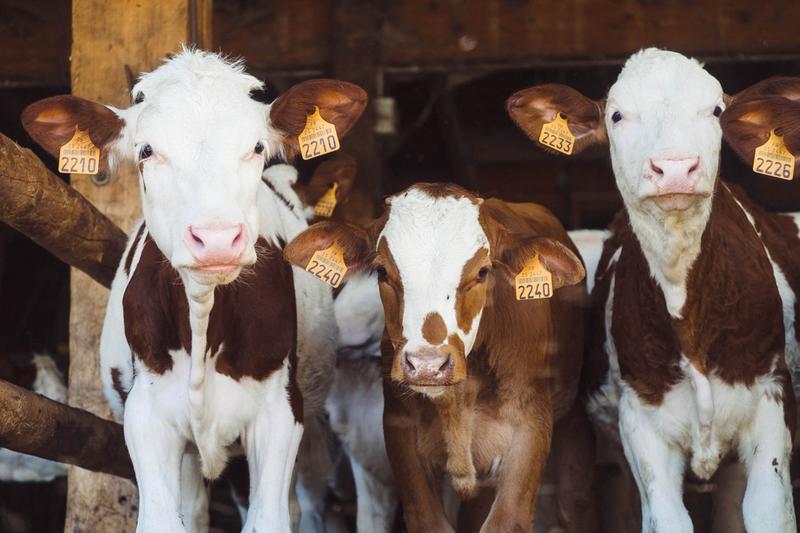Evolution of Cattle-Specialist Campylobacter
Genomic data is used by scientists and doctors around the world to respond to the threat of infectious diseases. In this series of blog posts, we’ll highlight research carried out by our group that uses genomic data to study disease-causing bacteria. The discoveries you are making through the Genome Detectives project will help us carry out more studies like these in the future!

This post discusses research into the evolution of Campylobacter jejuni strains to live specifically in cows. The research was carried out by the Sheppard Lab and colleagues, who we - the Maiden Lab - work closely with. You can read the full scientific paper “Agricultural Intensification and the Evolution of Host Specialism in the Enteric Pathogen Campylobacter jejuni” (Mourkas, et al., 2020), here.
Campylobacter infections
Campylobacteriosis (also known as bacterial gastroenteritis) is the most common type of food poisoning among humans, in the world1. The leading cause is Campylobacter jejuni, a species of bacteria that is normally found in the gut of a range of wild and domesticated animals. Infections in people are mainly due to eating raw or undercooked poultry or meat. Campylobacteriosis causes unpleasant symptoms including diarrhoea, fever, headache, and vomiting. People with campylobacteriosis usually recover fully in a short period of time, however it can cause severe health problems and may even be fatal in vulnerable populations such as young children and the elderly.
Campylobacter and cows
Intensive livestock farming systems aim to grow as many animals as possible on the amount of land available to them. Since the 17th Century, intensive farming practices have changed the distribution of animals on earth. Livestock – farmed animals – now accounts for 60% of all mammal biomass2 (including humans), so well over half the weight of all living mammals. There are an estimated 1.5 billion cows on Earth today, making cattle the most abundant livestock species.
Campylobacter bacteria are found in the gut of around 20% of cows. A cow on average produces 30kg of manure each day, and around 30,000 Campylobacter cells are present in each gram of manure – this means around 300 quadrillion (300,000,000,000,000,000) Campylobacter bacteria are excreted by cows into the environment every day!
The massive expansion of intensive farming practices over recent centuries has changed the proportion of Campylobacter host species that are livestock animals. It is important to understand how this change in livestock numbers has impacted Campylobacter evolution and adaptation, because changes to the bacteria’s structure or lifestyle may potentially increase the risk of it spreading to humans.
Adaptation to specific hosts
Campylobacter jejuni comes in a range of variants, or subtypes, of the species, which are referred to as strains. Most Campylobacter jejuni strains are regularly isolated from a range of animal species: they are ecological generalists, meaning they are adapted to survive in a wide range of hosts. However, the increase in livestock as Campylobacter hosts has led to the emergence of specialist strains – strains which are adapted to live in just one host species. Examples of specialist strains include ‘ST-61’ and ‘ST-42’, which are associated with cattle. Around half a million cases of campylobacteriosis are caused by these two strains each year in Europe alone, so increasing our understanding of them is key to improving our ability to tackle this disease.
Investigation of phylogeny
A phylogeny, or phylogenetic tree, is a branching diagram which shows the evolutionary relationships between various species, or between strains within a species of bacteria. In this study, over 1,000 Campylobacter jejuni genomes, sampled from 18 different host animal species, were used to create a phylogeny in order to investigate when and how adaptation has occurred in specialist cattle strains of Campylobacter jejuni.
Phylogenetic trees are created using genome data: the similarities and differences between the genomes of each sample are analysed by software, and this is used to predict how the samples have evolved in relation to each other.
The figure below, created during this study by Mourkas and colleagues, shows a phylogenetic tree where each dot represents a bacterial sample and the lines (‘branches’) between them show how the samples are related in terms of evolution, with shorter lines (ie. clusters of dots) meaning the samples are more closely related.
The dots are coloured based on the host species that sample was collected from: blue from cows, yellow from chickens, and white from other animals. Looking at the tree, you can see that many of the clusters contain samples from several host species (for example ST-21) – this indicates these strains are generalists. There are also some clusters of only one host species, for example ST-61, which indicates they are specialist strains for that host species.
The ST-61 strain forms a tight cluster at the tip of a longer branch that comes from within the ST-21 cluster. This suggests that this cattle-specialist strain has evolved from within a generalist strain.

Cattle-specialist adaptations
Having worked out the evolutionary relationships, the researchers then looked in more detail at the differences in genes present in generalist and in cattle-specialist strains. They identified 35 genes that were present in over 90% of the cattle-specialist ST-61 samples, but absent in over 90% of the generalist ST-21 samples. These genes could be involved in adaptation of C. jejuni to living specifically in cows. They included genes coding for structures on the bacterial cell and genes involved in movement, which are both factors known to impact colonisation of the animal gut. Although more research would be needed to conclusively prove the importance of these genes, this study suggests these genes have a possible role in adaptation to living in cattle specifically.
When did cattle-specialism arise?
To estimate the year at which the cattle-specialist ST-61 strain arose from the generalist ST-21 strain, the researchers used computer software to compare the genomes of samples where the sampling dates were known. The software uses a ‘molecular clock’ model, which is a mathematical way of explaining the relationship between genetic distance (the amount of difference between two genome sequences) and time. Through some complicated calculations, it is possible to estimate the date at which the two clusters of samples, ST-61 and ST-21, split off from each other. The cattle-specialist ST-61 strain is estimated to have first emerged in 1859 and then expanded throughout the 20th Century. This mid 19th century date correlates well with increasing levels of intensive cattle farming.
Summary
Analysis of Campylobacter genomes shows that strains adapted to living specifically in cattle have evolved from generalist strains, and uncovers possible genes involved in adaptation to this lifestyle. The emergence of these cattle-specialists correlates with the increase in intensive cattle farming seen over the last few centuries.
If you are keen to read about the evolution of Campylobacter cattle-specialists in more detail, you can find the paper by Mourkas, et al., here.
1. World Health Organisation, 2020.
Images (in order): Annie Spratt via Unsplash, 2016; Mourkas, et al., 2020.


